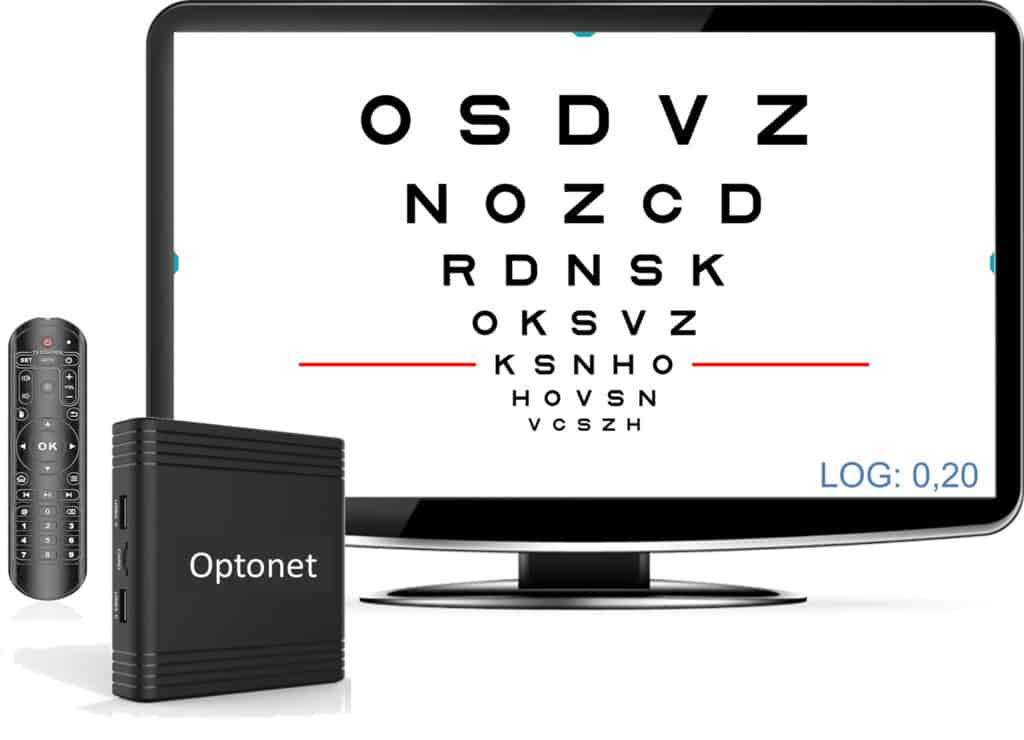Optonet Vision Unit Documentation
Please note that this User Guide is being currently updated; new sections will be added shortly.
1.1.Step 1. Choosing Hardware
The Optonet Vision Unit is compatible with all kinds of digital devices and runs in all regular operating systems, such as Windows or iOS, and even in TV streaming media players (like Amazon Fire TV stick or Cube), to suit all budgets. Depending on the clinician’s needs and budget, we recommend:
Distance Vision Testing in Clinic
To display charts just for distance vision we recommend a microcomputer (best option) or a TV player (budget option) connected to a monitor (e.g.: the Amazon Fire TV Cube offers an excellent quality/price ratio). You can also use a standard computer or laptop (most expensive option).

Optonet Vision Unit
Near Vision Testing in Clinic
For near vision testing, tablets are ideal.* A minimum screen size of about 10” and full HD resolution (1920x1200p) is recommended. The tablet can also be used as a remote controller for distance vision charts in the clinic, as explained in other section.

*A tablet from a well established brand is required for good image quality.
Domiciliary vision testing
For domiciliary visits (including school screenings) laptops are ideal, but tablets are also adequate. Optonet keeps on working even if internet connection is temporarily lost.
Now Optonet charts can also be displayed on a phone which may be useful for bedside testing or triaging in hospitals. Bear in mind that small phone screens limit what tests can be displayed (e.g. phones are too small for field testing).
Orthoptic Vision Training
Ideally, we recommend a laptop or standard computer, although TV players can also be suitable if higher models are used (like the Amazon Cube).
Remote consultations
Clinicians can use any standard computer with Internet access (e.g. desktop or laptop). Patients can use a computer, tablet or smartphone.
Monitor
In general, any standard flat computer screen may offer excellent image quality for distance vision testing in clinic.
Binocular vision tests require red/blue filters; but alternatively, Optonet can display binocular charts on 3D passive screens in combination with circular polarizing filters. Unfortunately, passive 3D monitors are no longer available in computer stores, they are only made to order in China and their price is higher than a conventional screen. For more information, please contact Optonet.
Size: For distance vision testing, a screen size of around 23” is ideal. A bigger or smaller screen will allow displaying a larger or smaller number of letters at once; however, larger screens (such as televisions**) may lose sharpness for smaller letters.
If looking for a larger screen (e.g., to replace standard ETDRS charts with same size and image quality), we recommend a 28-inch 4K monitor attached to a Mini-PC.
Resolution: Screen resolution must be at least Full HD (1920 x 1080 px), for optimal image sharpness.
Screen technology: IPS technology is highly advisable, especially for Contrast Sensitivity charts.
Built in speakers: These are advisable (either in the computer or screen), to hear the beeps that signal test changes.
VESA compliant for monitor wall mounting.
Example of monitor:
https://www.amazon.co.uk/Philips-243V7QDAB-23-8-Inch-Monitor-Speakers/dp/B06XZKTR88/
** Televisions are not recommended, since they offer lower image quality for letter charts at much higher cost.

